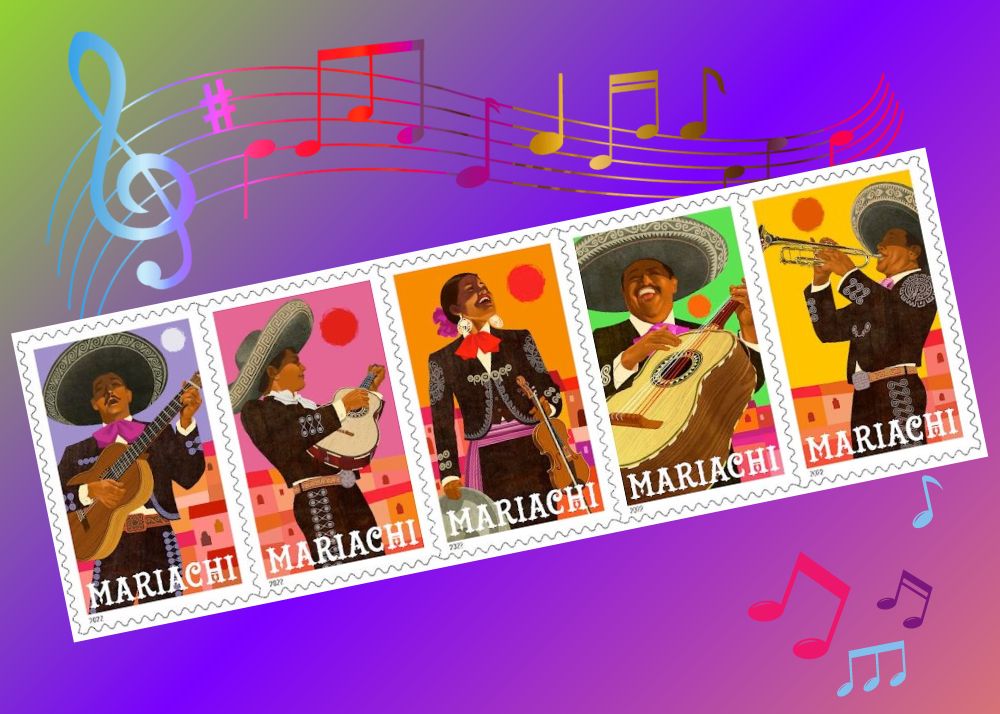The Big Passion Behind These Small Mariachi Stamps
These mariachi stamps that Rafael López recently designed for the U.S. Postal Service may be small, but the passion behind them and their impact is enormous! Find out where that passion comes from in our interview with this award-winning artist and illustrator.
By Lindsay López-Isa Lamken
Earlier this year, the United States Postal Service issued a series of five postage stamps celebrating the role of mariachi music in Hispanic and Latino/x culture in the United States. These gorgeous mariachi stamps were created by Rafael López, a prominent artist and illustrator who has won numerous awards for his work. Mr. López is particularly known for his illustration of children’s books and for his design and organization of community mural projects around the country. Mr. López was born in Mexico, and he currently splits his time between his homes in San Miguel de Allende (in Mexico) and San Diego, California, where he also has an art studio. Mr. López was kind enough to give Lateenz an interview, and I had a blast talking to him about his childhood, his approach to art, the mariachi stamps, and his advice for teens!
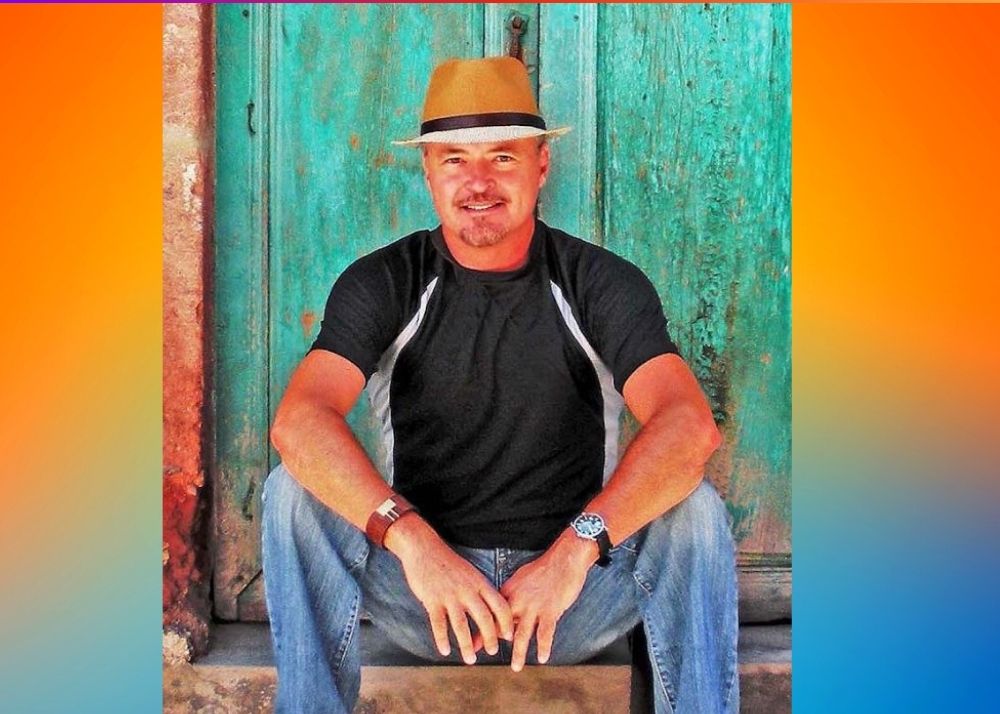 Image Credit: Courtesy of Rafael López
Image Credit: Courtesy of Rafael López
Lindsay López-Isa Lamken: Hi, Mr. López. I’m thrilled to be able to speak to you! A few weeks ago, my mom brought home some mariachi stamps from the post office, and I was just amazed by how beautiful they are. I went on Google to try to find out more about the mariachi stamps, and I saw that you had designed them. That led me down the internet rabbit hole of discovering all your beautiful artwork in addition to the mariachi stamps and learning about your interesting life and career. My research made me think that other teens would love to hear your thoughts on what it means to be Hispanic and an artist in the U.S. today, so thanks for agreeing to speak to me!
From my research, it seems like you had a remarkable childhood where you were exposed to the arts in a deep way. I’m especially amazed that you went to England at the age of ten to learn from another Latin American artist! Can you describe your childhood for our readers?
Rafael López: Yes! My childhood seems pretty unorthodox by today’s standards, but it wasn’t that uncommon at the time in Mexico City, where I was born. My parents were architects who studied at UNAM (the Universidad Nacional Autónoma de México). And my mom was definitely a groundbreaker. She has always been a rebel; even her nickname – “Pillo” – means “mischievous” in Spanish. She came from a family of all girls, and she was the black sheep – the one who didn’t follow the rules. She never wanted to do girls’ stuff and then, maybe around 1955, she decided she was going to become an architect. Her family and friends tried to convince her not to do it, but she became an architect anyway.
So, I guess it’s not surprising that my mom raised me to be a free spirit. I grew up in the 1960s surrounded by a lot of artists, painters, potters, and poets who were friends of my parents. It was common for us to have poetry readings at my parents’ house. When I first traveled to San Francisco and I heard all about the Haight Ashbury movement,* it seemed normal to me, because that’s what it was like for me growing up in Mexico, too. [*Haight Ashbury is a neighborhood in San Francisco that was famous for being at the forefront of the hippie and counterculture movement of the 1960s in the U.S.]
As a little kid, I went to a very special elementary school where there were no tests. The focus wasn’t on getting good grades. Instead, it was all about creating curiosity. So, for example, the teacher would bring a seed into the classroom, and he would ask, “What kind of a seed is this, and where does it grow? How do you make it grow, and how do you care for it?” His questions would start a conversation in class about agriculture and the environment. Then, the conversation would move on to socioeconomics and the politics in the country where the seed is grown. He would expand our minds with just a little seed. I thought it was so cool that the teachers focused more on the love of learning than on testing. It wasn’t just like, I’ll repeat this like a little parrot to get a good grade and then forget what it was all about next year, right?
So, that’s my background. I was free spirited and had long hair (back when I actually had hair! [laughs]) at a time when my cousins and all the other kids around me had short hair. And my parents would tell me just to be who I wanted to be. That’s why I really encourage people to fall in love with their passion and go for it. I’m very glad that my parents did that for me. If I had pursued a very safe career that I wasn’t excited about, I would have hated it after a while and been miserable. I’m grateful that they allowed me to follow my passion and that they were very supportive.
When did you first know that you wanted to be an artist?
Rafael López: I’m going to tell you a story that I’ve never mentioned in an interview before. Because my parents were architects, there were always drawings and blueprints around. One day, my dad was working on a project, and he left some blueprints on the table, ready to roll up and give to his client the next morning. I remember thinking that they seemed so boring because they were only in blue and white. So, I grabbed my markers, and I drew a sun on the blueprints and some trees and other things. When my father came back, he looked at the blueprints and said, “What have you done? I’m supposed to present these to the client tomorrow!” And I said, “Don’t they look better now?” That’s the kind of thing I did when I was a kid.
I was always encouraged to do art. In addition to my parents, the principal of my elementary school and my relatives were super, super supportive as well. My aunt would bring me boxes of crayons, and my uncle worked at a paper mill, and he would bring me big rolls of paper. My mom would clear out the furniture in the living room and put the big roll of paper out on the floor, and I would just lay on my belly and draw. If I ran out of paper, my mom would let me paint on the walls. She would say, “If you want to paint the walls, paint the walls! We’re architects, and we can always paint them back.” As far back as I can remember, I’ve always had a pencil or marker or crayon in my hand. And I still do! Even today, I have crayons around here . . . somewhere [laughs].
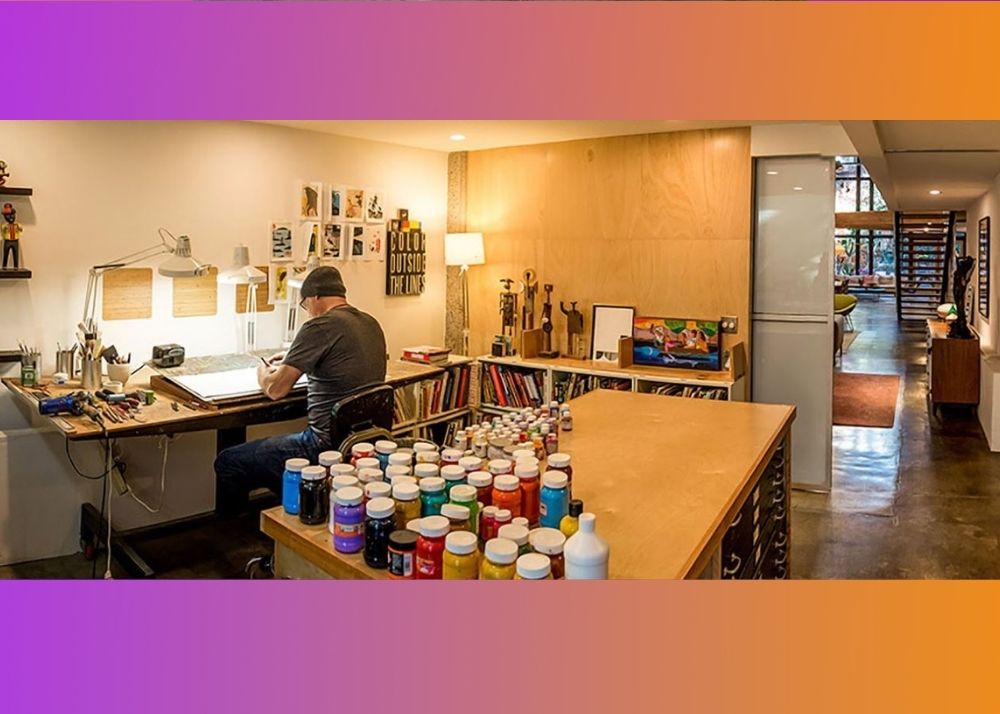 Image Credit: Courtesy of Rafael López/ Mr. López in his studio in San Diego
Image Credit: Courtesy of Rafael López/ Mr. López in his studio in San Diego
What do you remember most about being a teenager?
Rafael López: I had such a great time! I know that other teenagers, like my son, have a difficult time with the transition. I don’t know if it was just me, or if it’s that life was just different back then and more innocent, but I remember my teenage years being wonderful. When I was a teenager, my family moved close to the Mexican border. The culture of the border was very different than what I was used to in Mexico City, and, at first, the border kids teased me because I was the kid from Mexico City. But I was too cool to let it bother me. I just laughed along with them, and, eventually, they left me alone, because they could see that they weren’t getting to me.
Also, when I was a teenager, I had a teacher who encouraged me to go to art school at ArtCenter [the ArtCenter College of Design in Los Angeles]. I had never heard of ArtCenter, so he took me to the library to look at one of their course catalogs. I saw all this beautiful artwork in the catalog and said, “Wow, the teachers do awesome artwork!” He corrected me and told me that the art in the catalog was student work, not the work of the teachers. That’s when I was sold on going there. I asked my mom and dad if we could afford it. They told me that that they probably weren’t going to be able to leave me anything after they died, but that they were committed to giving me the best education they could provide. So, that’s what they did – and I got to go to ArtCenter.
As teens, we’re trying to figure out what to do with our lives, but it’s sometimes hard to know what different careers are like and what it takes to do them. Can you tell us how you became such a successful artist and illustrator? What training did you get, and what was your career path?
Rafael López: When I was young, I didn’t know for sure that I wanted to be an artist. I knew that I had a talent for drawing, but I was also scared by the thought of being an artist for a living. I had never really heard of any successful artists, except for three or four older guys who were friends of my parents. I thought maybe I would become a marine biologist or a geologist instead.
Then I had a conversation with the principal of my former elementary school. She had become friends with my parents over the years, so she really got to know me. She was at our house to celebrate Christmas, and she asked me, “Rafa, what are you going to do with your life?” When I told her that I was considering geology or marine biology, she looked me straight in the eyes and said, “No. You’re going to be an artist.” That was the message that I needed to hear at the time. I trusted that she was right and had a clear vision for me because she was older than me. On top of that, I didn’t want to disappoint her, so I became an artist – because I respected her so much. And then I just continued on that path, eventually studying at ArtCenter.
Art Center was a very tough school, but I loved the challenge. I love it when things get hard. At first, the other students just blew me away with their projects. Their work was so much more beautiful and awesome than mine. I realized that I wasn’t trying hard enough. And I learned more from my fellow students – from trying to compete with them – than from the actual teachers. The students would get together and exchange knowledge: How did you do that? How did you get that texture? How do you get that effect? Of course, the teachers did a remarkable job, too.
Beyond technique, my experience at ArtCenter also taught me some practical things that helped me as an artist. I learned to deal with failure; when something didn’t work out, I would just tell myself to get back up and give it another try. I learned to collaborate with others, to keep my ego in check, and to make sure that I was involved in group projects. All of those things were really important later on in my career.
I hear so many of my friends say that they have no artistic talent and could never learn to draw. Do you agree with that? Do you think it can be learned, or is it a combination of talent and training?
Rafael López: I think you can learn it. Early on at ArtCenter, I took a class where the teacher told us to focus on the negative areas around the figures we were drawing. So, imagine that you’re assigned to draw my face, but instead of looking directly at my face, you try to draw the negative space around my face. The teacher promised us that, by drawing this way, even the worst students would come out of the class very capable of drawing and of doing a great job.
I remember that my classmates and I were skeptical because we were convinced that you had to be born with artistic talent. In the end, though, what he said would happen came true! In the first month of the class, there were some kids who were really good at drawing, some kids who were OK, and some who were super bad. At the end of the year, though, everyone was at the same level!
I think the key is to train your mind to see things and to lose the fear of judgment. You also have to look inside yourself and ask, Who am I? What do I want to express, and how can I express it? How can I translate that music or those colors into a work of art? And sometimes, you have no idea. But you just have to get started. You have to put pencil to paper and start doodling.
People think art is all fun, but I say, “No, art is hard work.” There’s a lot of frustration. But I do think it’s something that you can learn. I’m not 100 percent sure there isn’t some part that you have to be born with, but I have seen people learn art with my own eyes.
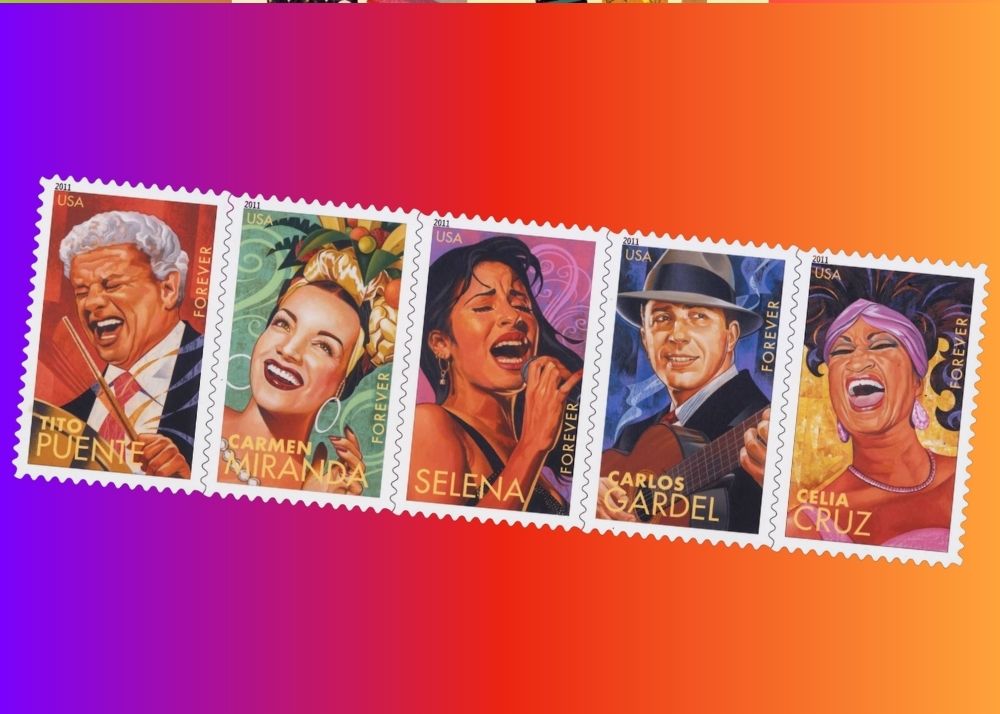 Image Credit: Courtesy of Rafael López/ Latin Music Legend Stamps created by Mr. López for the U.S Postal Service in 2011
Image Credit: Courtesy of Rafael López/ Latin Music Legend Stamps created by Mr. López for the U.S Postal Service in 2011
Many parents of Hispanic and Latino/x teenagers in the U.S. discourage their children from becoming artists. They worry that it’s a competitive industry and their kids may not be able to support themselves. What would you say to a young person in that situation who really wants to be an artist?
Rafael López: If you have a passion for art, I would say to find mentors around you. Find teachers that believe in you. Don’t be afraid to take a class. Go to a local college, like City College here in San Diego, and take a drawing class. Maybe your father really wants you to be a car mechanic or help him with his business on the weekends. If you do that, you may spend your life being resentful that you never achieved your dream.
I’ve seen so many young people come through the Graphic Design program in San Diego City College. My wife teaches there now, along with many talented former students. So many of those kids would come asking for help because they didn’t have anyone in their families supporting them. But they loved art, and some of them now have amazing jobs in places like San Francisco, Chicago, and New York. So, yes, the art world is competitive, but if you love what you do, you accept that competition. You do your work and wait for opportunities because you love what you’re doing.
Try to surround yourself with people who support you. Don’t give up on your dream because that would be a shame.
I’m really fascinated your all of your artwork (not just the mariachi stamps!), and I was hoping you could tell me a bit about two of your pieces, like what inspired you to create them and what they mean to you. For example, in this image, there is a girl who is being lifted up to touch the sun by four human arms of different skin tones, surrounded by what look like vines. Can you tell me a little about this piece?
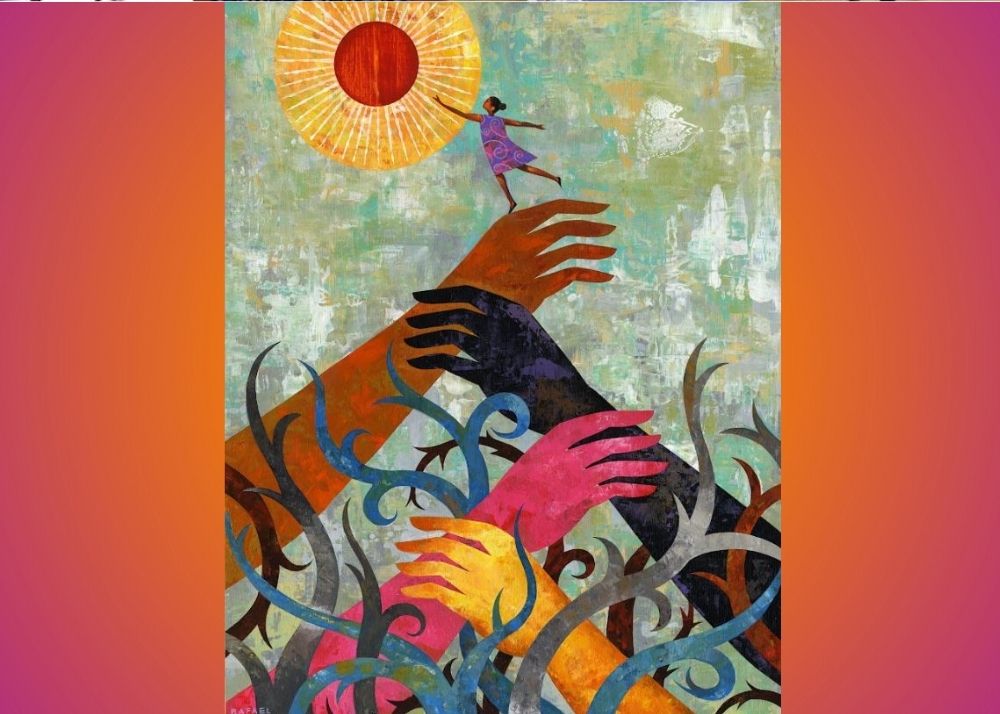 Image Credit: Courtesy of Rafael López / Painting created for Oprah Winfrey
Image Credit: Courtesy of Rafael López / Painting created for Oprah Winfrey
Rafael López: This piece has an interesting story. I got a call one day asking if I would make three original paintings for Oprah Winfrey. She was scheduled to talk about a school that she created to help young girls in South Africa who had faced a lot of challenges in their lives. I said I would do it, of course, but on the condition that I could meet Oprah. I was told that, yes, I could travel to Chicago and give the paintings to her personally.
This is one of the paintings that I did for her. It’s basically about the girls in her school in South Africa and all the people who are lifting them up to success. Because “it takes a village,” right? I was trained at school to be a conceptual illustrator, so my work is very symbolic. In this painting, I’m saying that young people need parents, teachers, mentors, and friends – in addition to their own efforts – to get through the vines [which represent difficulties in life] and reach the sun [which represents success].
In the end, it was really fun to meet Oprah. It was funny, though, because she greeted me like she had known me for years, and I was so starstruck I couldn’t even talk to her [laughs].
Before this interview, you sent me an image made up of nine separate portraits. The portraits are of Hispanic, Latino/x, and indigenous peoples in completely different contexts and time periods. Can you explain who these people are and why you painted them?
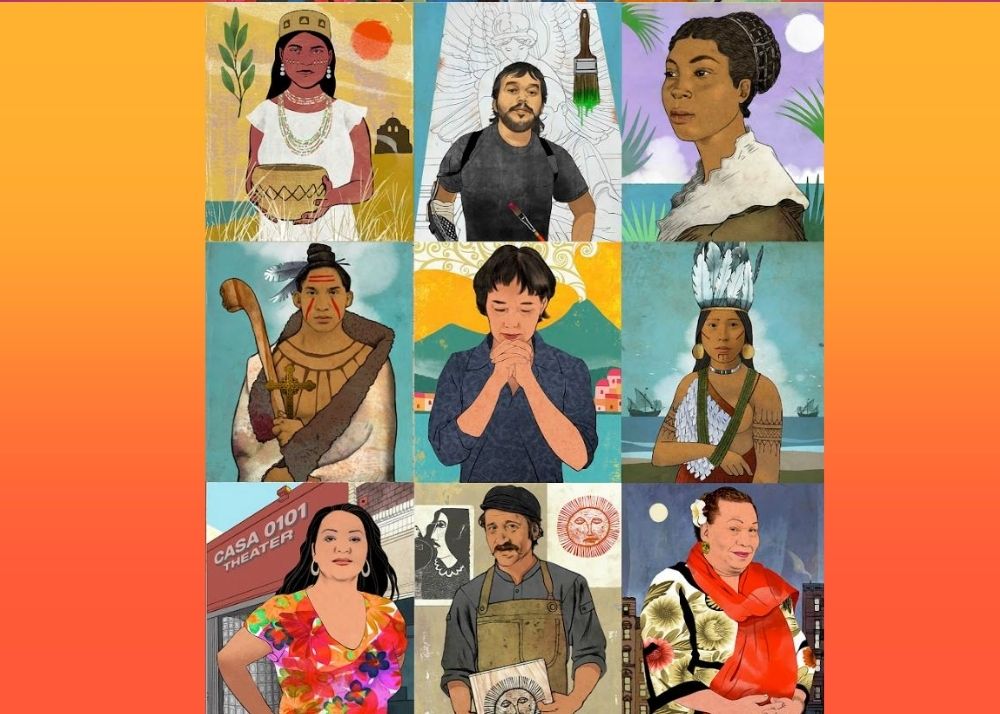 Image Credit: Courtesy of Rafael López / Paintings created by Rafael López for the National Museum of the American Latino in Washington, D.C.
Image Credit: Courtesy of Rafael López / Paintings created by Rafael López for the National Museum of the American Latino in Washington, D.C.
Rafael López: These works are some of the 54 portraits that I just finished for the Smithsonian Museum of the American Latino in Washington, D.C. I got a call about two years ago from some people telling me that the Smithsonian Institute was planning to build a museum on the National Mall celebrating Latino culture and history in the United States. They said that the museum was going to take at least ten years to finish, so, in the meantime, the Smithsonian was going to open a gallery – the Molino Family Latino Gallery – inside the National Museum of American History. They asked me to create 54 portraits to highlight the lives of Latinos who have made important contributions to the U.S., but who may not have been given a spotlight in history before. I thought, Wow, 54 portraits is a lot, but I can’t say no to the Smithsonian, it’s such an honor! And they told me I had a year to finish them, so I figured I could do it.
The idea behind the portraits is to show that many, many Latinos have made important contributions to the United States. Some of the portraits are of Latinos that people may recognize, like Tito Puentes and Celia Cruz. But most of the portraits are of people that that no one has ever heard of – or at least I had never heard of them. I got some background on them from the Smithsonian, and I also had to do some of my own research. I found out what amazing things they did to help create the U.S.A. And there’s so many more Latinos that we could have highlighted. We could have gone on forever!
So, in the end, this project was all about saying, Hey, Latinos are part of the whole history of the U.S., and now you can find out about us. I was very honored to be invited to do these portraits.
Can you tell us a little about your artistic process? For example, what steps did you follow and what media did you use in creating the mariachi stamps?
Rafael López: When a client hires me to work on something, the first thing I do is ask them to tell me more about what they want to see. What is the goal of the project? I take notes and spend about a week just thinking about which way I want to go with it. Then I do research, finding reference images and creating mood boards. In the case of the mariachi stamps, I mostly used photos from a book on mariachis. This saved me a lot of time. The photos in the book were great, and the author gave us permission to use whichever ones we wanted.
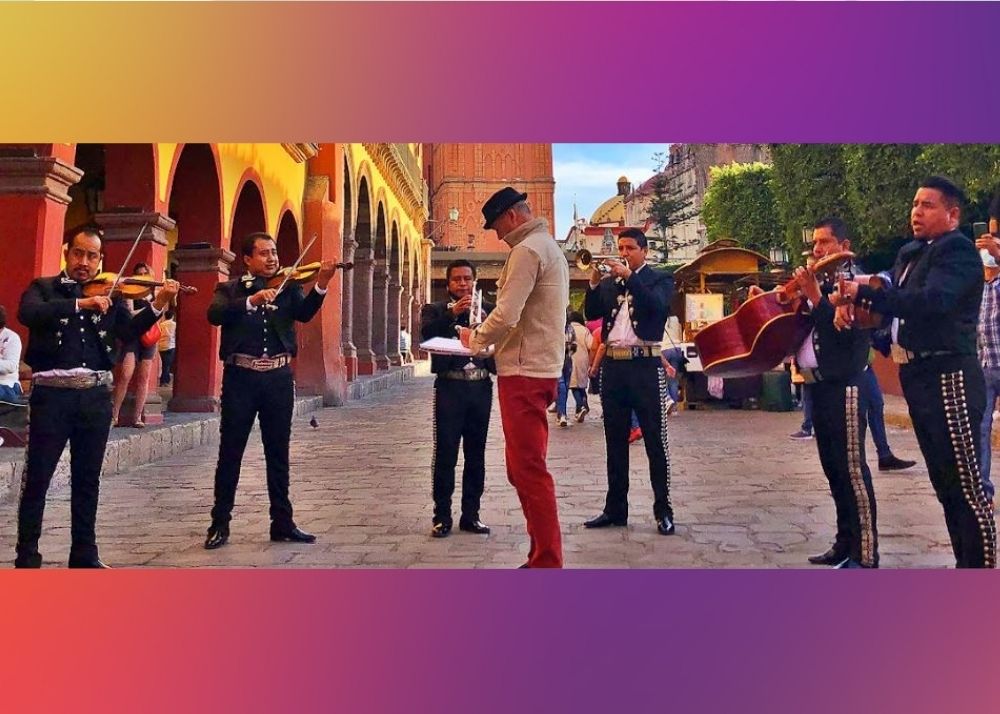 Image Credit: Courtesy of Rafael López / Research for mariachi stamps
Image Credit: Courtesy of Rafael López / Research for mariachi stamps
First, I did pencil sketches and a lot of composition. I didn’t just use one photo for each mariachi stamp – I would maybe combine the head of a person in one photo with the body of a person in another photo. I also used my knowledge of anatomy to exaggerate the style. If a mariachi was standing straight, I might bend him a little bit to make it more dramatic.
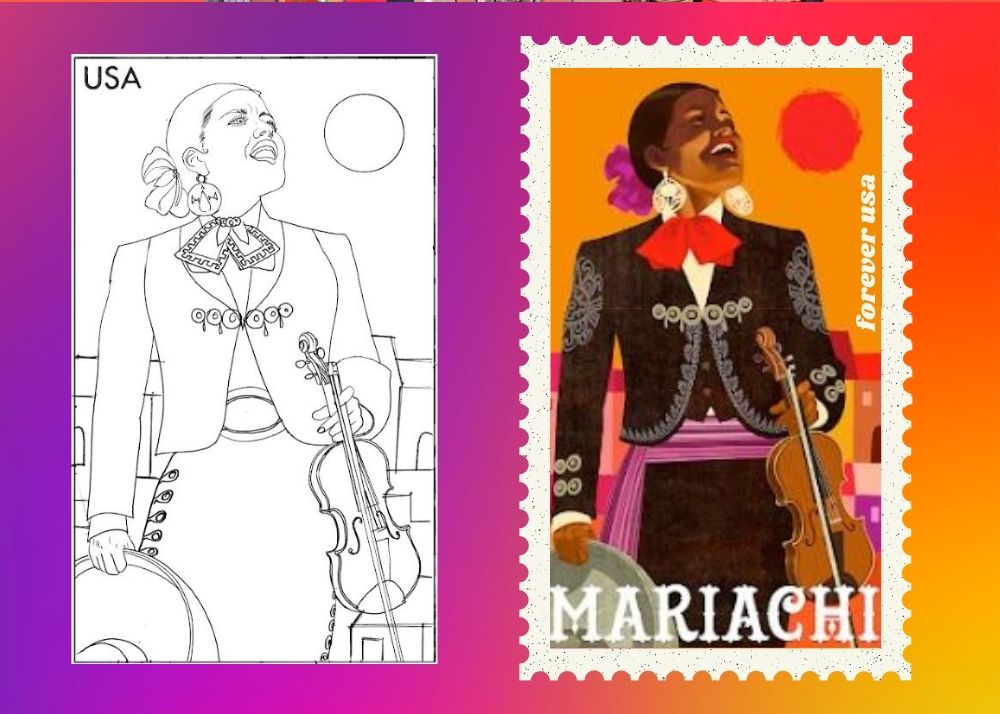 Image Credit: Courtesy of Rafael López / Mariachi stamp creative process – from sketch to stamp
Image Credit: Courtesy of Rafael López / Mariachi stamp creative process – from sketch to stamp
When I finished the pencil drawings, I sent them back to the client [the U.S Postal Service] with a few color ideas. I told them that I wanted the mariachi stamps to be very colorful and also a little nostalgic – similar to the look of movie posters from the Mexican golden age of cinema in the 1930-40s – and they agreed.
Originally, they [the U.S Postal Service] were just going to commission one mariachi stamp. But I didn’t think it would work to have five mariachis on one stamp, and I thought that Latinos deserved a better homage than just one stamp. So, I convinced them that we should do five stamps and that one of the stamps should be of a woman mariachi, because women have been contributing to the mariachi tradition in the U.S. for many years.
Next, I used rollers and brushes to create cool textures on watercolor paper and then scan them into my computer. I usually create about 30 different textures and colors for a project. After that, I used a computer tablet to layer the textures onto the sketches. All the elements were handpainted, but by working with the layers on the tablet, I was able to move everything around, resize things, and make other changes. This part of the process took about two to three weeks for each of the five paintings, for a total of about five months. At that point, I sent the paintings for the mariachi stamps to the client for one last revision.
In total, I worked on the mariachi stamps for about a year. And during that whole time, I was collaborating with the client’s art director. When I work, I don’t want it to be just like, This is my creation and I don’t care what you people think. I really like collaborating.
What has been your favorite project to work on to date?
Rafael López: Wow, that’s a hard question, because I have so many favorites! But I’ll tell you what brings me a lot of satisfaction. I love creating children’s books. I get to speak in schools, and I get to see children hold the books that I’ve worked on. A lot of times, they’ll say, “This is my favorite book, could you sign it?” or “Oh, I can’t believe this is your book, and I got to meet you!” I really love having that connection with readers and kids, and I feel like a star for a minute when that happens.
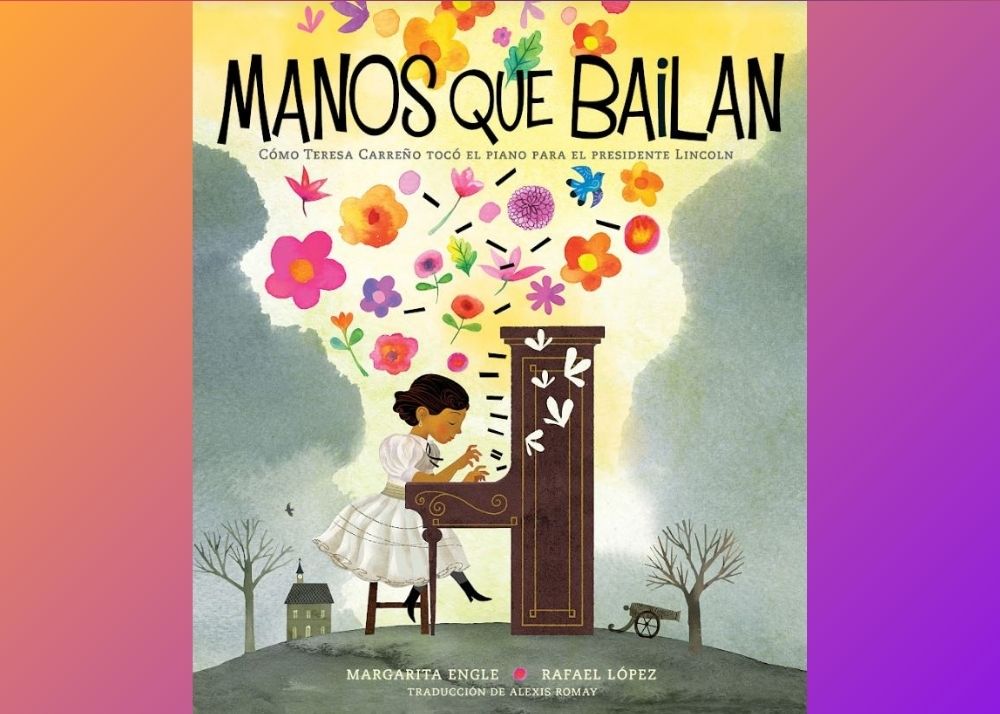 Image Credit: Courtesy of Rafael López / Book cover illustration by Rafael López
Image Credit: Courtesy of Rafael López / Book cover illustration by Rafael López
That connection is also a reason why I love organizing community murals. I love to get people involved with my work. I design the murals, and I direct them, but people from the community actually trace them onto the walls and they paint them. I teach people from beginning to end how to create a mural. Sometimes, there will be a three-year-old painting in one area and a twelve-year-old in another. I have even had older people come over to paint. The whole community comes together. It’s physically demanding work, but it’s so rewarding.
In terms of personal reward, I would say my community murals come first and my children’s books are a close second.
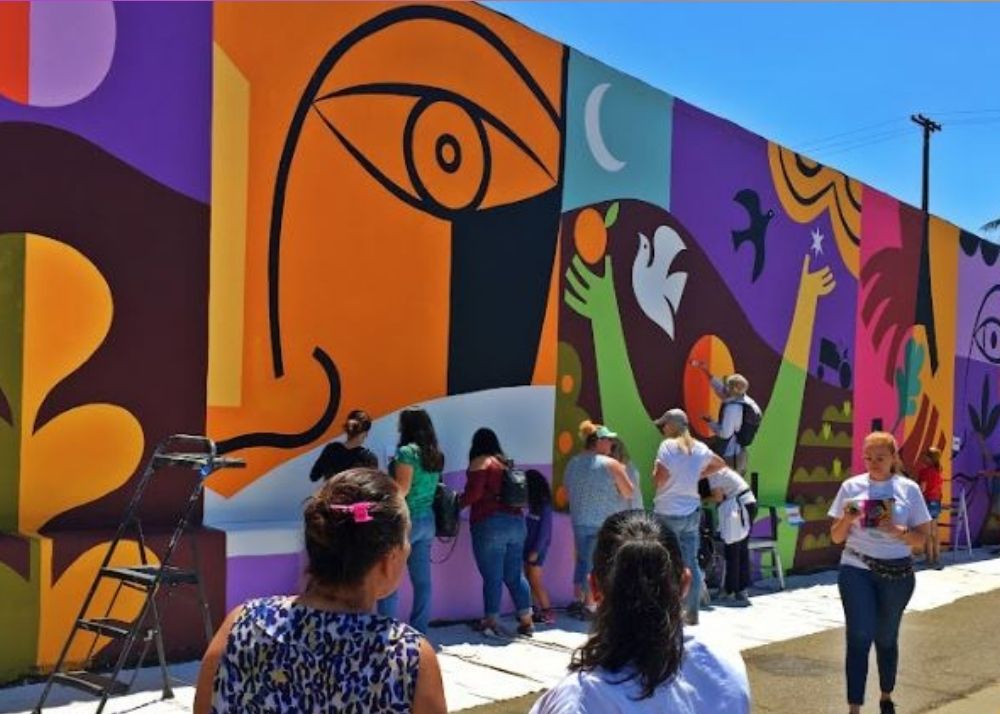 Image Credit: Courtesy of Rafael López / A community mural project led by Rafael López
Image Credit: Courtesy of Rafael López / A community mural project led by Rafael López
Is there anything else that you want our readers to know about you or your work?
Rafael López: I like to play music. I’ve played the guitar since I was five. I could barely even hold the guitar because it was so big — I played a bass. But I like to play my guitar when I’m stressed or I get a mental block – and, at my age, I get mental blocks all the time! [Laughs.]
Mr. López, I’m so very grateful that you agreed to share some of your valuable time with me. Thank you so much for doing this interview. It has really been fun!
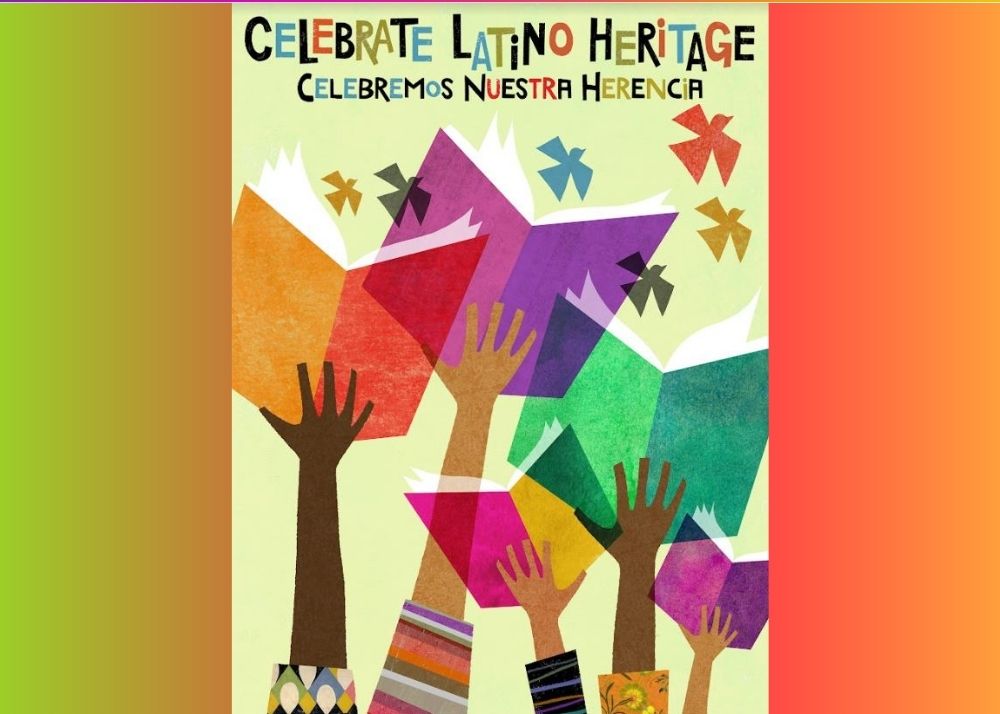 Image Credit: Courtesy of Rafael López / A poster by Rafael López
Image Credit: Courtesy of Rafael López / A poster by Rafael López
You can read even more about Rafael López’s life, career, and awards, here.
Hey, Lateenz readers! Are you interested in a career in art? If so, you owe it to yourself to check out our Teen Resources pages. You’ll find lots of high school internships, middle and high school programs, competitions and awards for middle and high school students, and scholarships for high school seniors interested in art and other areas (many of which do outreach to Hispanic and Latino/x teens). And check out our article about a high school internship in Cincinnati where teens help create community murals!
For more on Hispanic and Latino/x culture, and to find out about the latest internships, programs, competitions and scholarships for middle and high school students (many of which do outreach to Hispanic and Latino/x teens), be sure to follow us on Instagram and Twitter.
Related articles
-
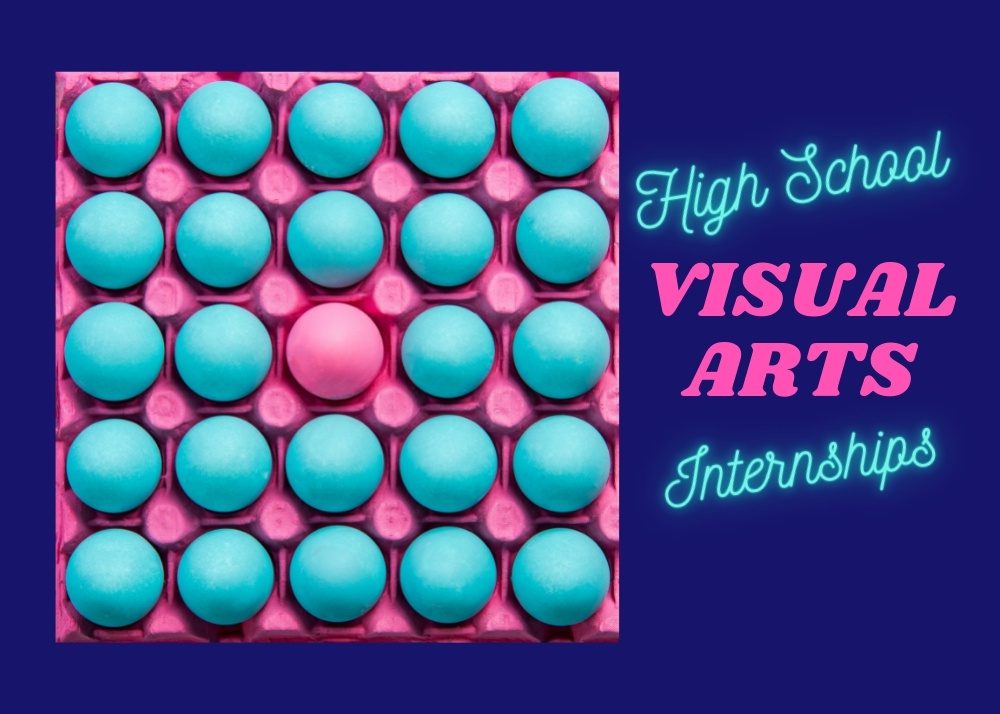 Student Life7 Great High School Internships in the Visual ArtsOctober 18
Student Life7 Great High School Internships in the Visual ArtsOctober 18 -
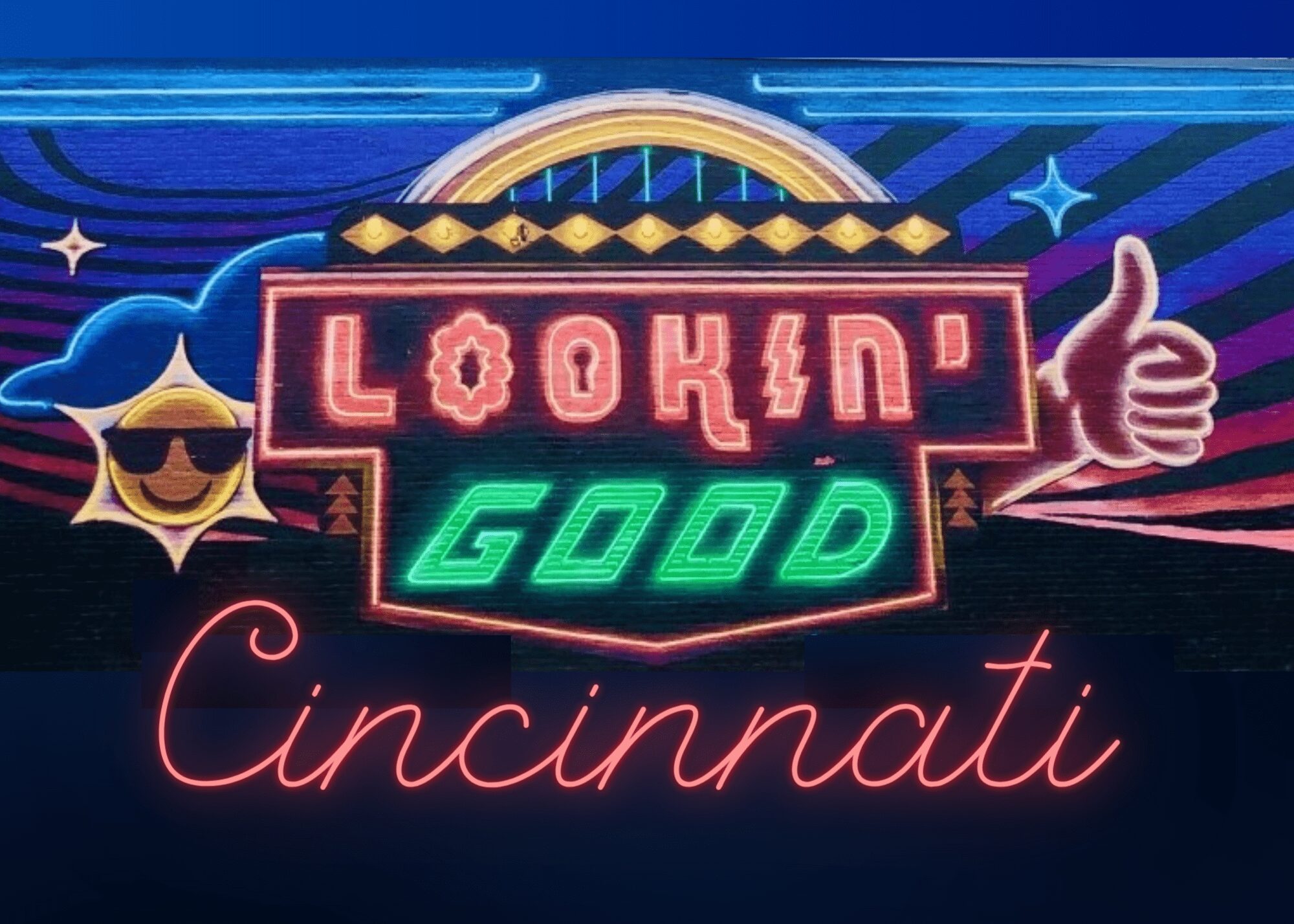 Info / InspirationHigh School Internship Spotlight: ArtWorks CincinnatiAugust 26
Info / InspirationHigh School Internship Spotlight: ArtWorks CincinnatiAugust 26 -
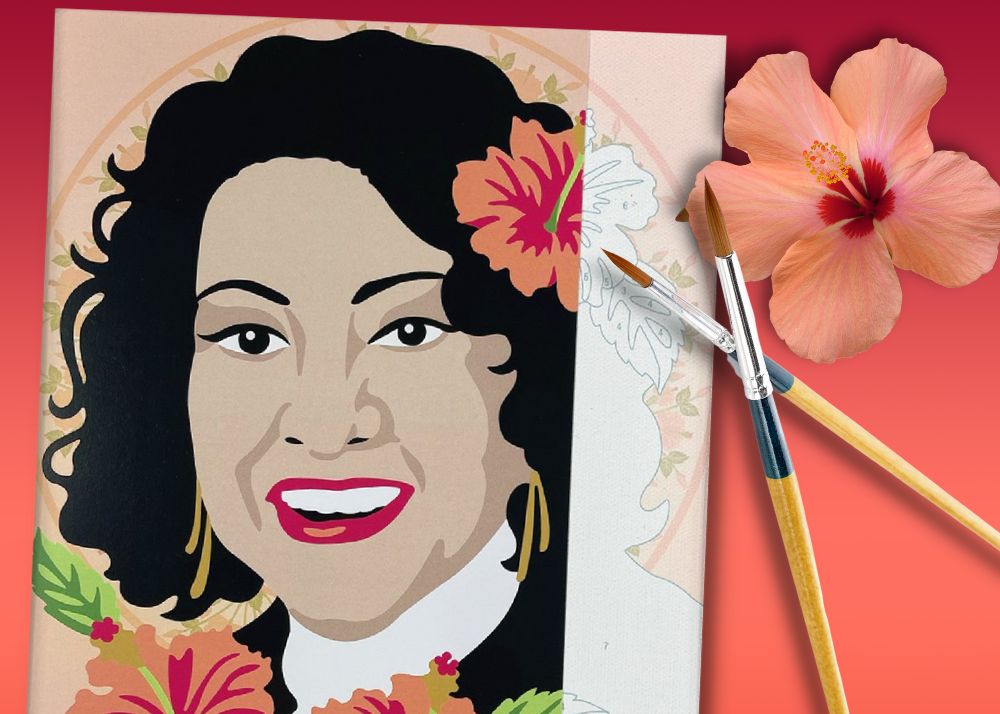 PlayA Paint-By-Number Celebration of Hispanic and Latino/x CultureSeptember 29
PlayA Paint-By-Number Celebration of Hispanic and Latino/x CultureSeptember 29 -
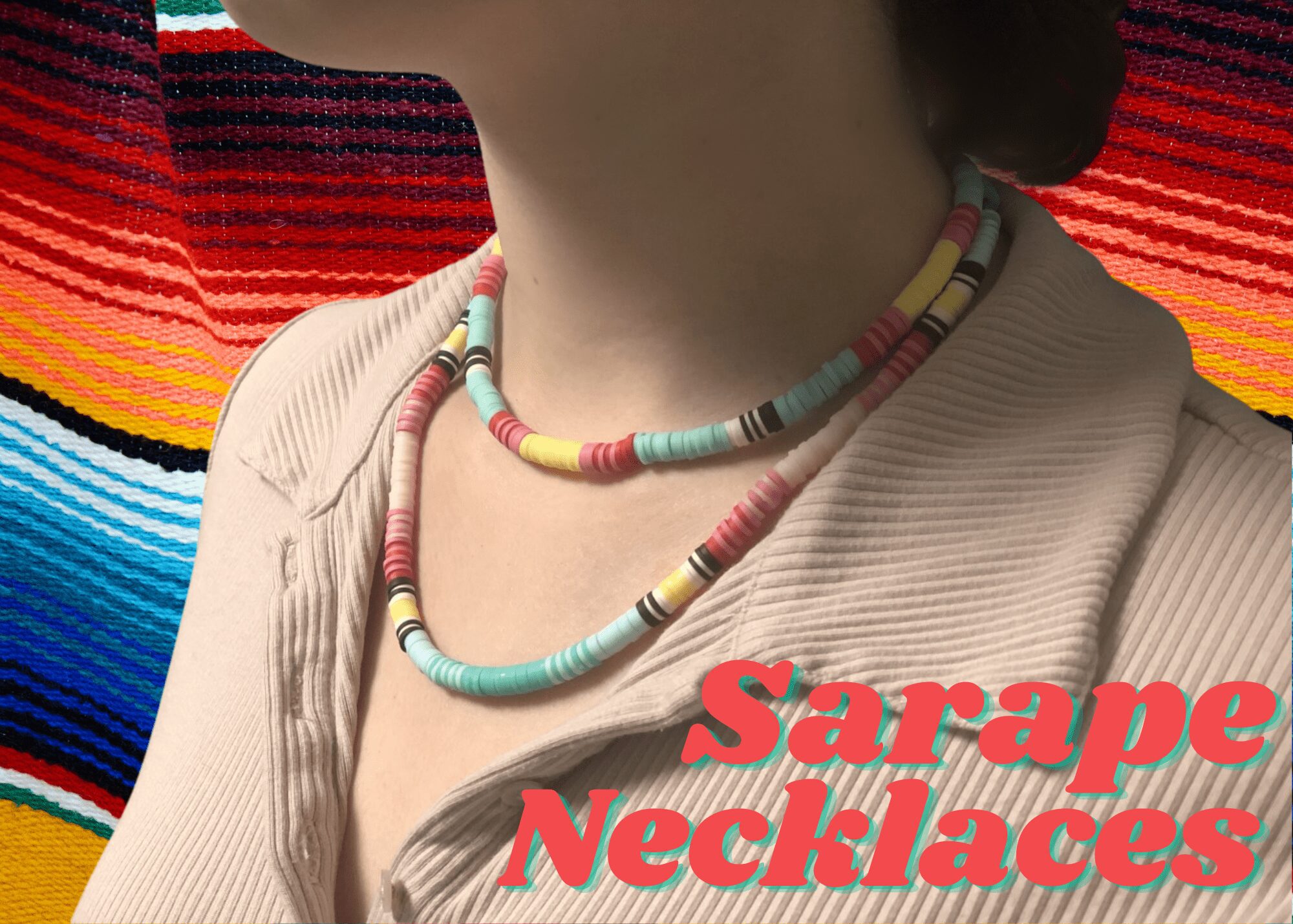 PlayDIY: Sarape NecklacesSeptember 08
PlayDIY: Sarape NecklacesSeptember 08 -
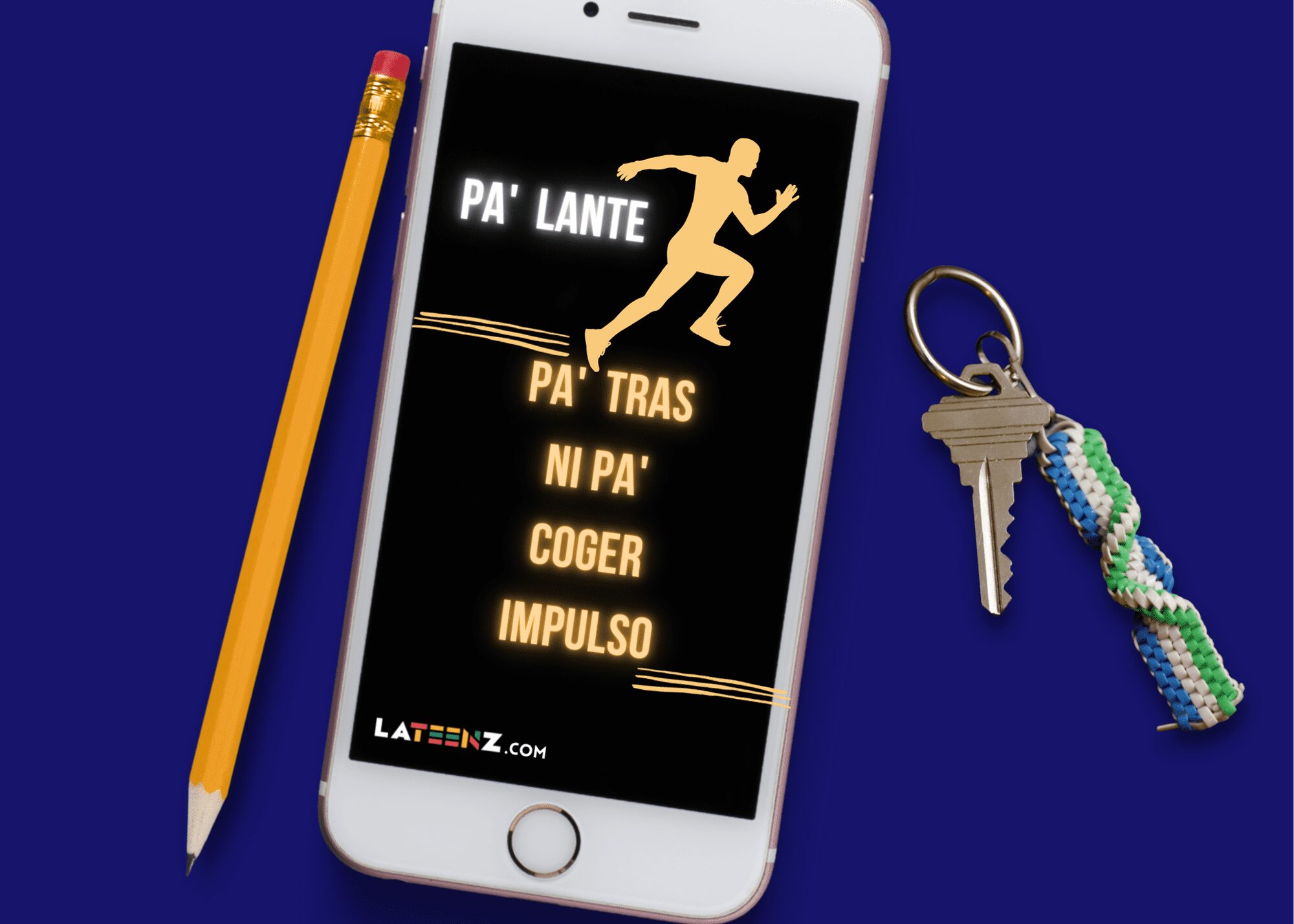 PlayFree “Pa’lante!” Phone WallpaperAugust 04
PlayFree “Pa’lante!” Phone WallpaperAugust 04
Most popular
-
 Student Life35 Top Science Competitions for High School StudentsJanuary 31
Student Life35 Top Science Competitions for High School StudentsJanuary 31 -
 Info / InspirationVoto Para La Mujer Quarter is a Major “Change”!July 29
Info / InspirationVoto Para La Mujer Quarter is a Major “Change”!July 29 -
 Student Life35+ High School Internships in the Bay AreaJanuary 22
Student Life35+ High School Internships in the Bay AreaJanuary 22 -
 Student Life90+ Best Writing Competitions for High School StudentsApril 13
Student Life90+ Best Writing Competitions for High School StudentsApril 13 -
 Student Life45+ Exciting Environmental Science Internships for High School StudentsOctober 18
Student Life45+ Exciting Environmental Science Internships for High School StudentsOctober 18

